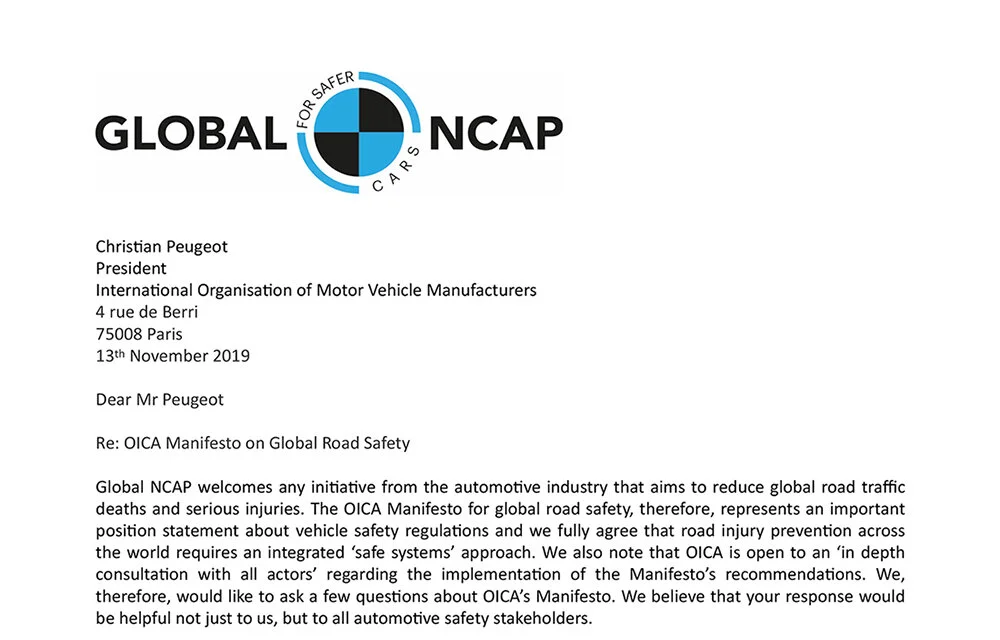Christian Peugeot
President
International Organisation of Motor Vehicle Manufacturers 4 rue de Berri
13th November 2019
Dear Mr Peugeot
Re: OICA Manifesto on Global Road Safety
Global NCAP welcomes any initiative from the automotive industry that aims to reduce global road traffic deaths and serious injuries. The OICA Manifesto for global road safety, therefore, represents an important position statement about vehicle safety regulations and we fully agree that road injury prevention across the world requires an integrated ‘safe systems’ approach. We also note that OICA is open to an ‘in depth consultation with all actors’ regarding the implementation of the Manifesto’s recommendations. We, therefore, would like to ask a few questions about OICA’s Manifesto. We believe that your response would be helpful not just to us, but to all automotive safety stakeholders.
The Manifesto does not refer to the proposal made by Mr Jean Todt, the UN Secretary General’s Envoy for Road Safety, for an industry self-commitment on minimum standards submitted to the 170th Meeting of the World Forum for Harmonisation of Vehicle Regulations in November 2016. The Manifesto also does not acknowledge a similar encouragement of voluntary action made in June 2017 by Mr Michael Bloomberg, the WHO’s Global Ambassador for Non-Communicable Diseases and Injuries2. Is it the intention of the automobile manufacturers or OICA to respond positively to such calls for voluntary commitments to global minimum vehicle standards?
The Manifesto does not mention anywhere the Global Road Safety Performance Targets endorsed by the UN General Assembly resolution 72/271. You will be aware that these include a target for vehicles (number 5) which reads as follows: By 2030, 100% of new (defined as produced, sold or imported) and used vehicles meet high quality safety standards, such as the recommended priority UN Regulations, Global Technical Regulations, or equivalent recognized national performance requirements.
We also note that the Manifesto’s list of recommended legal requirements does not include regulations for either child occupant protection and their restraint systems or pedestrian protection. Both are among the recommended priority UN regulations referred to in Target 5. Can you explain OICA’s decision to exclude child restraints and pedestrian protection given their obvious relevance to the safety of vulnerable road users?
We note the suggested timetable for implementation of OICA’s recommended legal requirements but are very surprised at the long lead times proposed. For example, you are requesting an implementation period of 60 months for electronic stability control. The current global fitment rate for ESC in light duty vehicles is estimated to be 78% in 2019 and will reach 84% by 2022. This growth is being supported by regulatory commitments already made in important emerging markets such as Brazil and India. It is, therefore, very hard to understand why OICA thinks universal application of ESC requires a further period of five years. We also note with concern that OICA has not included ESC as a proposed legal requirement for commercial vehicles. Is OICA aware that an implementation period of five years does no more than follow the existing market growth for ESC fitment?
We would be very grateful for answers to these questions and to engage in further dialogue with OICA about your Manifesto. Ahead of the 3rd Global Ministerial Conference on Road Safety to be held in Stockholm on February 19th-20th it is very important that key stakeholders such as the automobile industry undertake significant commitments to help achieve the road safety related Sustainable Development Goals. Unfortunately, our initial assessment of the OICA Manifesto is that it falls short of the action required. At present it seems to consist only of a legislative wish list for international harmonization with significant omissions as regards child and pedestrian safety and an overly long implementation period. This level of ambition will also do little or nothing to achieve Target Number 5 for safer vehicles by 2030.
We, therefore, fully concur with the UN Special Envoy’s call for “manufacturers to go further by anticipating as much as possible the implementation of these legislative obligations”. In this regard, we would encourage OICA to agree to voluntarily commit to implement all the Manifesto’s proposed legal recommendations (amended to include child restraints and pedestrian protection) by the end of 2020. This would be a fitting way for the automotive industry to make a powerful contribution to the end of the UN Decade of Action for Road Safety and would be an excellent commitment to make at the 3rd Global Ministerial in Stockholm.
Looking forward to your reply. Yours sincerely
David Ward President and CEO
cc:
Mr Jean Todt, UN Secretary General’s Envoy for Road Safety
Mr Michael Bloomberg, WHO’s Global Ambassador for Non-Communicable Diseases and Injuries





